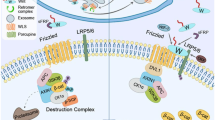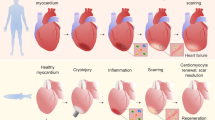Abstract
The epithelial–mesenchymal transition (EMT) plays a crucial role in the differentiation of many tissues and organs. So far, an EMT was not detected in the development of the auditory organ. To determine whether an EMT may play a role in the morphogenesis of the auditory organ, we studied the spatial localization of several EMT markers, the cell–cell adhesion molecules and intermediate filament cytoskeletal proteins, in epithelium of the dorsal cochlea during development of the rat Corti organ from E18 (18th embryonic day) until P25 (25th postnatal day). We examined by confocal microscopy immunolabelings on cryosections of whole cochleae with antibodies anti-cytokeratins as well as with antibodies anti-vimentin, anti-E-cadherin and anti-β-catenin. Our results showed a partial loss of E-cadherin and β-catenin and a temporary appearance of vimentin in pillar cells and Deiters between P8 and P10. These observations suggest that a partial EMT might be involved in the remodelling of the Corti organ during the postnatal stages of development in rat.






Similar content being viewed by others
References
Arnold W, Anniko M (1990) The cytokeratin skeleton of the human organ of Corti and its functional significance. Laryngo-rhino-otologie 69(1):24–30
Bauwens L, Veldman JE, Ramaekers FCS, Bouman H, Huizing EH (1991) Expression of intermediate filament proteins in the adult human cochlea. Ann Otol Rhinol Laryngol 100(3):211–218
Chen P, Segil N (1999) p27kip1 links cell proliferation to morphogenesis in the developing organ of Corti. Development 126:1581–1590
Colucciguyon E, Portier MM, Dunia I, Paulin D, Pournin S, Babinet C (1994) Mice lacking vimentin develop and reproduce without an obvious phenotype. Cell 79(4):679–694
Eriksson JE, Dechat T, Grin B, Helfand B, Mendez M, Pallari HM, Goldman RD (2009) Introducing intermediate filaments: from discovery to disease. J Clin Invest 119(7):1763–1771
Herrmann H, Strelkov SV, Burkhard P, Aebi U (2009) Intermediate filaments: primary determinants of cell architecture and plasticity. J Clin Invest 119(7):1772–1783
Kalluri R, Weinberg RA (2009) The basics of epithelial-mesenchymal transition. J Clin Invest 119(6):1420–1428
Kelley MW (2006) Regulation of cell fate in the sensory epithelia of the inner ear. Nat Rev Neurosci 7(11):837–849
Kelley MW (2007) Cellular commitment and differentiation in the organ of Corti. Int J Dev Biol 51(6–7):571–583
Kelley MW, Driver EC, Puligilla C (2009) Regulation of cell fate and patterning in the developing mammalian cochlea. Curr Opin Otolaryngol Head Neck Surg 17(5):381–387
Kim K, Daniels KJ, Hay ED (1998) Tissue-specific expression of beta-catenin in normal mesenchyme and uveal melanomas and its effect on invasiveness. Exp Cell Res 245(1):79–90
Kobayashi Y, Nakamura H, Funahashi JI (2008) Epithelial-mesenchymal transition as a possible mechanism of semicircular canal morphogenesis in chick inner ear. Tohoku J Exp Med 215(3):207–217
Kuijpers W, Peters TA, Tonnaer E, Ramaekers FCS (1991a) Expression of cytokeratin polypetptides during development of the rat inner-ear. Histochemistry 96(6):511–521
Kuijpers W, Tonnaer E, Peters TA, Ramaekers FCS (1991b) Expression of intermediate filaments proteins in the mature inner-ear of the rat and guinea-pig. Hear Res 52(1):133–146
Kuijpers W, Tonnaer E, Peters TA, Ramaekers FCS (1992) Developmentally-regulated coexpression of vimentin and cytokeratins in the rat inner-ear. Hear Res 62(1):1–10
Mogensen MM, Henderson CG, Mackle JB, Lane EB, Garrod DR, Tucker JB (1998) Keratin filament deployment and cytoskeletal networking in a sensory epithelium that vibrates during hearing. Cell Motil Cytoskelet 41(2):138–153
Mu MY, Chardin S, Avan P, Romand R (1997) Ontogenesis of rat cochlea. A quantitative study of the organ of Corti. Dev Brain Res 99(1):29–37
Oesterle EC, Sarthy PV, Rubel EW (1990) Intermediate filaments in the inner ear of normal and experimentally damaged guinea pigs. Hear Res 47(1–2):1–16
Osborn M, Debus E, Weber K (1984) Monoclonal antibodies specific for vimentin. Eur J Cell Biol 34(1):137–143
Ramaekers FCS, Huysmans A, Schaart G, Moesker OPV (1987) 5. Cytoskeletal proteins as markers in surgical pathology. In: Ruiter DJ, Fleuren GF, Warnaar SO (eds) Application of monoclonal antibodies in tumor pathology Martinus Nijhoff Publishers. Dordrecht, Boston, pp 65–85
Riou P, Saffroy R, Chenailler C, Franc B, Gentile C, Rubinstein E, Resink T, Debuire B, Piatier-Tonneau D, Lemoine A (2006) Expression of T-cadherin in tumor cells influences invasive potential of human hepatocellular carcinoma. Faseb J 20(13):2291–2301
Roth B, Bruns V (1992a) Postnatal-development of the rat organ of Corti. 1. General morphology, basilar-membrane, tectorial membrane and border cells. Anat Embryol 185(6):559–569
Roth B, Bruns V (1992b) Postnatal-development of the rat organ of Corti. 2. Hair cell receptors and their supporting elements. Anat Embryol 185(6):571–581
Sakuma H (1998) Regional variations of the cytokeratin expression along the guinea pig cochlear turn. Nihon Jibiinkoka Gakkai kaiho 101(11):1348–1357
Sato M, Leake PA, Hradek GT (1999) Postnatal development of the organ of Corti in cats: a light microscopic morphometric study. Hear Res 127(1–2):1–13
Savagner P (2010) The epithelial-mesenchymal transition (EMT) phenomenon. Ann oncol Off J Eur Soc Med Oncol/ESMO 21(Suppl 7):vii89–vii92
Simonneau L, Gallego M, Pujol R (2003) Comparative expression patterns of T-, N-, E-cadherins, beta-catenin, and polysialic acid neural cell adhesion molecule in rat cochlea during development: Implications for the nature of Kolliker’s organ. J Comp Neurol 459(2):113–126
Thelen N, Breuskin I, Malgrange B, Thiry M (2009) Early identification of inner pillar cells during rat cochlear development. Cell Tissue Res 337(1):1–14
Thiery JP, Acloque H, Huang RY, Nieto MA (2009) Epithelial-mesenchymal transitions in development and disease. Cell 139(5):871–890
Toivola DM, Strnad P, Habtezion A, Omary MB (2010) Intermediate filaments take the heat as stress proteins. Trends Cell Biol 20(2):79–91
Whitlon DS (1993) E-Cadherin in the mature and developing organ of Corti of the mouse. J Neurocytol 22(12):1030–1038
Wikstrom SO, Anniko M, Thornell LE, Virtanen I (1988) Developmental stage-dependent pattern of inner ear expression of intermediate filaments. Acta Otolaryngol 106(1–2):71–80
Yilmaz M, Christofori G (2009) EMT, the cytoskeleton, and cancer cell invasion. Cancer Metastasis Rev 28(1–2):15–33
Zeisberg M, Neilson EG (2009) Biomarkers for epithelial-mesenchymal transitions. J Clin Invest 119(6):1429–1437
Zhang L, Hu Z (2012) Sensory epithelial cells acquire features of prosensory cells via epithelial to mesenchymal transition. Stem Cells and Development [Epub ahead of print]
Acknowledgments
The authors thank Mrs. Patricia Piscicelli for her skilful technical assistance. They would like also to thank Sandra Ormenese (GIGA-Imaging and Flow Cytometry, University of Liège) and Dr Pierre Leprince (Western blots, University of Liège) for their technical supports. This work was supported by the Fonds de la Recherche Scientifique and the Recherche dans l’Industrie et dans l’Agriculture.
Author information
Authors and Affiliations
Corresponding author
Electronic supplementary material
Below is the link to the electronic supplementary material.
418_2012_969_MOESM1_ESM.png
Fig. S1 Western blots showing the vimentin (lane 1), cytokeratin 8 (lane 2), E-cadherin (lane 3), β-catenin (lane 4), upper panel, and β-actin (lanes 2–4), bottom panel, expression, in freshly isolated cochlea (lane 1), liver (lanes 2 and 3) and lung (lane 4) from rat. The results are in total agreement with previous data (Table S1) (PNG 47 kb)
418_2012_969_MOESM2_ESM.png
Fig. S2 Immunolocalization of different cytoskeletal proteins in the basal turn of the cochlear duct. a–a′ Only the epithelial cells and not the mesenchymal cells are E-cadherin-positive (red) at P6. b–b′ All the epithelial cells are β-catenin-positive (red) at P12. A β-catenin labelling is also observed in the mesenchymal cells of the basilar membrane. c–c′ The vimentin labelling (green) is essentially present over the mesenchymal cells at P10. The sensory cells of the Corti organ are specifically detected with an anti-myosin VI antibody (red). d–d′ Like E-cadherin, only the epithelial cells are CK8-positive (red) at P0. The cell nuclei are visualised with DAPI staining (blue). D(1–3) Deiters’ cells, Ip inner pillar cell, I inner hair cell, O(1–3) outer hair cell, Op outer pillar cell, RM Reissner membrane, SL spiral limbus, SV stria vascularis, TC tunnel of Corti, V spiral vessel. Bar 10 µm (PNG 2879 kb)
418_2012_969_MOESM3_ESM.doc
Table S1 Specifications of different primary antibodies used in the study. (1) Data shown in the manufacturer; (2) Osborn, Debus, et al. 1984; Eur J Cell Biol 34(1): 137–143; (3) Pagan, Sanchez, et al., 1999; Journal of Hepatology; 31: 895–904; (4) Zou, Yaoita, et al., Virchows Archiv : an international journal of pathology 448 (4): 485–492; (5) Harborth, Elbashir, et al., 2001. Journal of Cell Science 114, 4557–4565; (6) Yang, Ju, et al. 2011; J Cell Biochem 112: 2558–2565; (7) Kim, Daniels, et al. 1998; Exp Cell Res 245(1):79–90 (DOC 42 kb)
Rights and permissions
About this article
Cite this article
Johnen, N., Francart, ME., Thelen, N. et al. Evidence for a partial epithelial–mesenchymal transition in postnatal stages of rat auditory organ morphogenesis. Histochem Cell Biol 138, 477–488 (2012). https://doi.org/10.1007/s00418-012-0969-5
Accepted:
Published:
Issue Date:
DOI: https://doi.org/10.1007/s00418-012-0969-5




